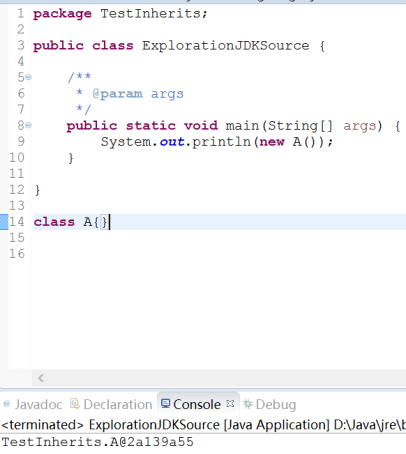1、运行 TestInherits.java 示例,观察输出,注意总结父类与子类之间构造方法的调用关系修改Parent构造方法的代码,显式调用GrandParent的另一个构造函数,注意这句调用代码是否是第一句,影响重大!
class Grandparent {
public Grandparent() {
System.out.println("GrandParent Created.");
}
public Grandparent(String string) {
System.out.println("GrandParent Created.String:" + string);
}
}
class Parent extends Grandparent {
public Parent() {
super("Hello.Grandparent.");
System.out.println("Parent Created");
// super("Hello.Grandparent.");
}
}
class Child extends Parent {
public Child() {
System.out.println("Child Created");
}
}
public class TestInherits {
public static void main(String args[]) {
Child c = new Child();
}
}
将super放在首行结果:

结论:
通过 super 调用基类构造方法,必须是子类构造方法中的第一个语句。
2、为什么子类的构造方法在运行之前,必须调用父类的构造方法?能不能反过来?为什么不能反过来?
必须调用,不能反过来,构造函数的作用就是初始化
子类继承了父类的各种属性,而构造方法则相当于把父类给实例化出来。所以一定会先调用父类的构造方法。
3、参看ExplorationJDKSource.java示例此示例中定义了一个类A,它没有任何成员:
class A { }
示例直接输出这个类所创建的对象
public static void main(String[] args) {
System.out.println(new A());
}
我们得到了一个奇特的运行结果:
A@1c5f743
为什么?

前面示例中,main方法实际上调用的是:
public void println(Object x),这一方法内部调用了String类的valueOf方法。valueOf方法内部又调用Object.toString方法:
public String toString() {
return getClass().getName() +"@" +
Integer.toHexString(hashCode());
}
hashCode方法是本地方法,由JVM设计者实现:
public native int hashCode();
4、我们来看一段代码(示例Fruit.java ):

注意最后一句,一个字串和一个对象“相加”,得到以下结果,为什么?

分析:Fruit类覆盖了Object类的toString方法。在“+”运算中,当任何一个对象与一个String对象,连接时,会隐式地调用其toString()方法,默认情况下,此方法返回“类名 @ + hashCode”。为了返回有意义的信息,子类可以重写toString()方法。
5、请自行编写代码测试以下特性(动手动脑):
在子类中,若要调用父类中被覆盖的方法,可以使用super关键字。
(1)覆盖方法的允许访问范围不能小于原方法。
(2)覆盖方法所抛出的异常不能比原方法更多。
(3)声明为final方法不允许覆盖。
例如,Object的getClass()方法不能覆盖。
(4)不能覆盖静态方法。
代码:
package TestInherits;
public class Person {
String name;
int age;
double score;
void introduce(){
System.out.println("我的名字是:"+name+",我的年龄是:"+age+",我的成绩是:"+score);
}
}
package TestInherits;
public class Student extends Person{
void introduce(){
System.out.println("我的名字是:"+name+",我的年龄是:"+age+",我的成绩是:"+score);
}
}
package TestInherits;
public class Fruit {
public static void main(String[] args) {
// 生成子类对象,调用子类的方法
Student a=new Student();
a.name="hsn";
a.age=10;
a.score=99.0;
a.introduce();
// 生成父类对象,调用父类的方法
Person b=new Person();
b.name="hhh";
b.age=20;
b.score=120;
b.introduce();
}
}
结果:
